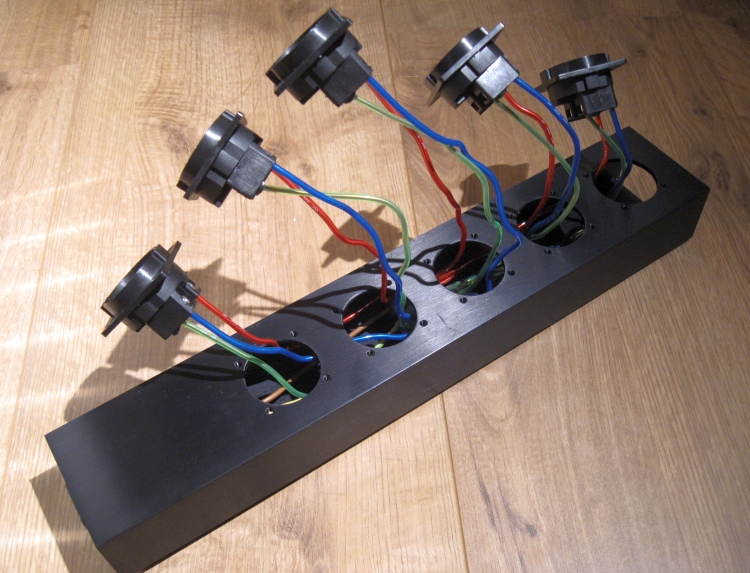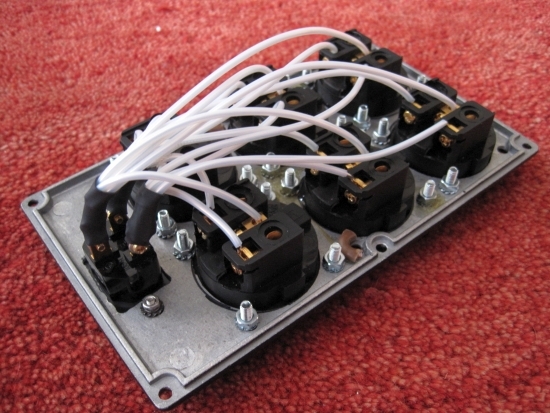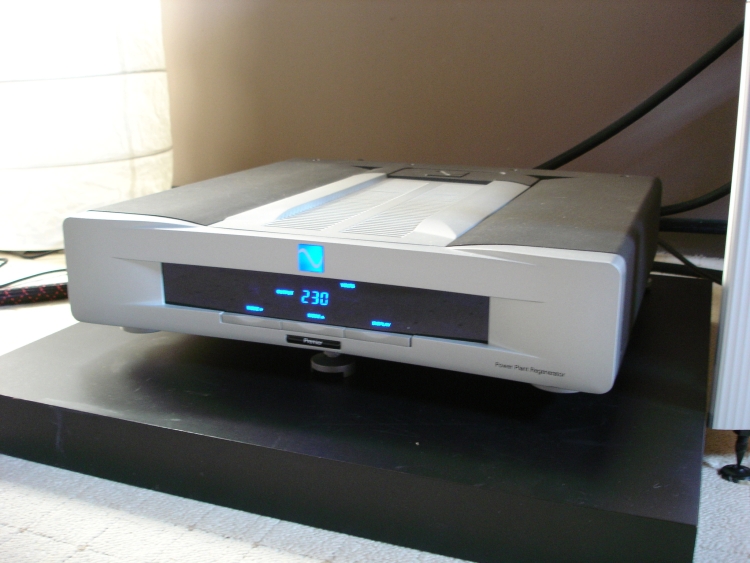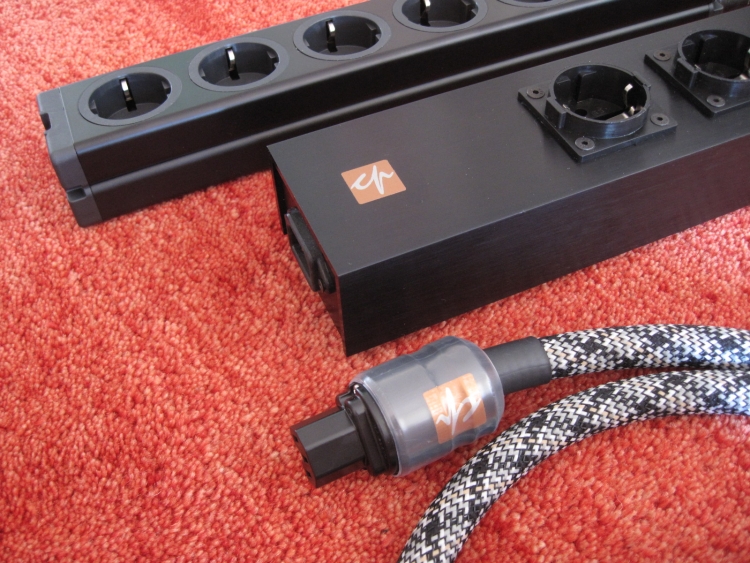
Much more important than given credit for!
According to many technicians, it should not be possible to hear differences between different kinds of power conductors. If so, then surely the power supply of the connected component must be faulty or badly designed. Well, if that is the case then there must really be not a single well-designed or well-working audio component out there because each and every one that I tried responded to power cords.
If you’re reading articles on this site, you’re probably no stranger to the idea that power cords make for large differences in sound. But as I discovered when designing extension blocks I noticed that even lengths of 10cm or less can make a distinct difference. Without going into detail too much, I can say that in this process, I went through tens of possible conductor candidates, trying each and everyone to achieve the balance I wanted. Over the course of this, I had the idea to connect the 6 outlets in one extension block with different wire and on purpose not make a note of what was where so that I wouldn’t influence myself during listening. In an effort to add a level of double-blind listening, I invited a friend whom I told nothing about what I’d done. This was admittedly more like single-blind testing, but that’s still better than open-eyed listening, I guess. What I had installed was 1. pure silver wire, 2. a mix of gold and silver wire and 3. pure copper wire and 4. another variant where I used the same conductor but with a different sleeve.

Well, what do you know?! We could easily distinguish between all the variants used. Gold-silver was the clear winner. This was to be expected as it was with a large margin the most expensive conductor but in audio, you just never know, so I was still surprised. What’s more, my listening partner, who knew nothing about the conductors used, arrived at the same conclusion. What we also found was that despite the star wiring, you could still hear small differences between the 6 outlets, probably because the length of the cable varies from socket to socket. In most cases, the first position sounded best (being most natural).
But we also discovered that you can also hear the sleeve that surrounds the conductor. When we listened to the same conductor with sleeving A and sleeving B it was as if we were listening to two completely different brands of cable! Again, I was glad that I had left my friend in the dark because that kept him in an objective position when he proclaimed the one a winner over the other.
At a later date, I decided to further up the game by also test the ground cabling used. I wired half the extension block with the same conductor as I used for the live and neutral and wired the other half with ordinary installation wire. Again I left the friend in the dark as to what he was hearing. And of course, we could hear a difference! In the case of earthing the differences are definitely smaller than for the live and neutral positions but still, you could make out the type used.
What’s more, and this may be hard to believe, you can even hear these differences when not using earthed wall outlets. I’ll let that one sink in… Yes, even when you’re not actually using the earth you can hear what kind of conductor was used for it. I think that this may be so because at the component level, earth is still inter-connected and as such wires all components together via the mains cables. On that note, I’ve also heard differences when you’re just sticking a cable in a vacant outlet of an extension block while not connecting the other end of the cable to anything. In this case, you still hear that cable’s character.
Conclusion
Just like with power cables, short connecting leads exhibit similar differences as power cords. Even lengths of 10 cm or less have a certain “sound”. What you’ll hear are things like warm versus cool, fast versus slower and more rounded and lively versus damped. Of course, the interpretation is relative to circumstances and open to personal taste.
I can go on about the differences between solid core and litze, silver plating and mixing conductors but I think you get the point. The bottom line is that in audio everything matters. Never make the mistake to underestimate the importance of seemingly unimportant little things like the conductors inside extension blocks.


Hi what brand and where do you buy the Gold-silver cabel used in this test.
Is it suitable to make powercord from?
Regards
Jan Karlsson
Sweden
That was Mundorf solid core silver-gold wire and I guess you could make a powercable from them. Just note that at 55 euro per single strand of 1 meter this is not cheap cable.
Goedemorgen Christiaan,
Ik loop een stekker blok tegen het lijf die jij hebt gebouwd als ik het goed heb. Het gaat om een CP Audio Reference V2.
Als ik jouw tijd in beslag mag nemen en een paar vragen mag stellen: Deze vs de Clarity die je destijds hebt gebouwd wat is het grootste verschil? Zijn er op de Reference V2 nog speciale IEC inlets gebruikt en outlets? Is deze starwired? Het blok is 10 jaar oud ongeveer en ik vraag mij af hoe deze het zou doen in het vergelijk met de nieuwere blokken van tegenwoordig. De netsnoeren zitten er ook bij van CP audio.
Hartelijk dank voor je tijd Christiaan.
Regards,
Viktor
Hi Victor,
The Clarity is wired using only solid core silver/gold wire with an IeGO Gold inlet and standard good quality bronze/brass (I don’t recall) outlets.
The Reference V2 is wired using a combination of solid core installation wire and solid core OCC wire. Funnily enough, I tried it first using only OCC but that sounded dull, hence the combination that worked out perfectly. The inlet is an expensive Oyaide but I forget the plating type. The outlets are standard good quality Bals.
Both are star-wired for phase, neutral, and ground.
Between the two, the Clarity is a little lean but beautifully detailed and highly refined while the Reference is very well-rooted and solid but less airy. I personally feel that the Reference V2 has the most neutral balance. How they compare to the current competition is something I will leave to the owners to decide. In any event, I still use the Reference V2 sometimes during reviews and a good friend still uses it on a daily basis for his main system.
Thank you very much Chrisitaan that will help me out! All the best!
Regards
Dag Christiaan,
Ik lees mooie recensies over de cp stekkerblokken. Ik speel momenteel met een Vibex stekkerblok, klinkt mooi maar in het hoog/midden ietwat ingehouden. Vraag is waar zijn de cp blokken verkrijgbaar? Hoor graag van je.
Mvg,
Arnold
Hi Arnold, alas, the CP-Audio distributors are no longer made.
Dag Christiaan,
Dank voor je bericht. Dat is inderdaad jammer.
Mvg,
Arnold